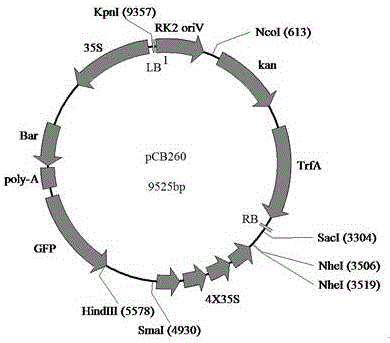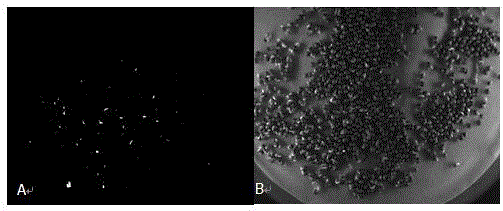Method for obtaining brassica napus material suitable for high-density planting and mechanized harvesting
A high-density, rapeseed technology, applied in plant genetic engineering and biological fields, can solve the problems of high planting cost and high harvest loss rate, and achieve the effect of simple operation, low cost and fast speed
- Summary
- Abstract
- Description
- Claims
- Application Information
AI Technical Summary
Problems solved by technology
Method used
Image
Examples
Embodiment 1
[0050] Example 1: Transformation of Activation Tag Vector pCB260 into Wild-type Rapeseed Oil 12
[0051] 1. The activation tag vector pCB260 was transformed into Agrobacterium competent cell GV3101 (purchased from Shanghai Maiqi Biotechnology Co., Ltd.)
[0052] (1) Take about 5 μL of the activation tag vector pCB260 and add it to 50 μL of Agrobacterium competent cells GV3101
[0053] In the bacterial solution, mix slowly.
[0054] (2) Put it in an ice box for an ice bath for half an hour, quickly take it out and transfer it to liquid nitrogen to freeze for 1 minute (or place it in
[0055] -70°C refrigerator, 3-5 minutes), quickly placed in a 37°C water bath for 5 minutes.
[0056] (3) Add 800 μL LB liquid medium (without antibiotics), shake at 250 rpm at a constant temperature of 28°C
[0057] Beds were incubated for 4-5 hours. Centrifuge at 3500 rpm for 30 seconds, suck out the upper layer and discard it.
[0058] (4) Add 100 μL LB liquid medium (without antibiotics) a...
Embodiment 2
[0074] Embodiment two, rape transformed plant screening
[0075] 1. Using green fluorescent protein GFP to screen seeds harvested by flower dipping (method 1)
[0076] (1) Treatment of rapeseed seeds: select about 1000 seeds of the transformed plants obtained in Example 1, place them in a large Petri dish covered with filter paper, arrange the seeds evenly, add a small amount of water until the seeds are soaked, and then darkly treat 2- 3 days.
[0077] (2) Observation of fluorescence: After the seeds sprout, they can be placed in an optical image analysis system (purchased from Shanghai Tianneng Technology Co., Ltd.) for observation, and the exposure time is adjusted to 50s during observation. like figure 2 As shown, compared with the wild-type Ningyou 12, the mutant plants containing the pCB260 vector obviously emitted green fluorescence, that is, the white dots in the figure.
[0078] (3) Transplanting: Gently pick out the fluorescent seeds and place them in small squar...
Embodiment 3
[0095] Embodiment three, less branched rapeseed mutant sfz Phenotyping
[0096] Through the method described above, among a large number of transformed strains, a mutant of oligobranched rapeseed was found sfz, And the plant conforms to the law of Mendelian inheritance in the growth of the F2 generation, and its phenotype analysis shows that compared with the wild-type Ningyou 12 plant, the mutant at the seedling stage sfz shiny leaves ( Figure 5 ), the mature mutant sfz There are fewer branches, the effective branch height is increased, and the siliques are concentrated at the top of the plant.
[0097] Image 6 oligobranched rapeseed mutant sfz Comparison of flowering plants and wild-type plants; the inflorescences and siliques of the less-branched rapeseed mutant are concentrated at the top of the plant, and the effective branch height is significantly higher than that of the wild-type Ningyou 12 plant, which is very suitable for dense planting and mechanized har...
PUM
 Login to View More
Login to View More Abstract
Description
Claims
Application Information
 Login to View More
Login to View More - R&D
- Intellectual Property
- Life Sciences
- Materials
- Tech Scout
- Unparalleled Data Quality
- Higher Quality Content
- 60% Fewer Hallucinations
Browse by: Latest US Patents, China's latest patents, Technical Efficacy Thesaurus, Application Domain, Technology Topic, Popular Technical Reports.
© 2025 PatSnap. All rights reserved.Legal|Privacy policy|Modern Slavery Act Transparency Statement|Sitemap|About US| Contact US: help@patsnap.com



